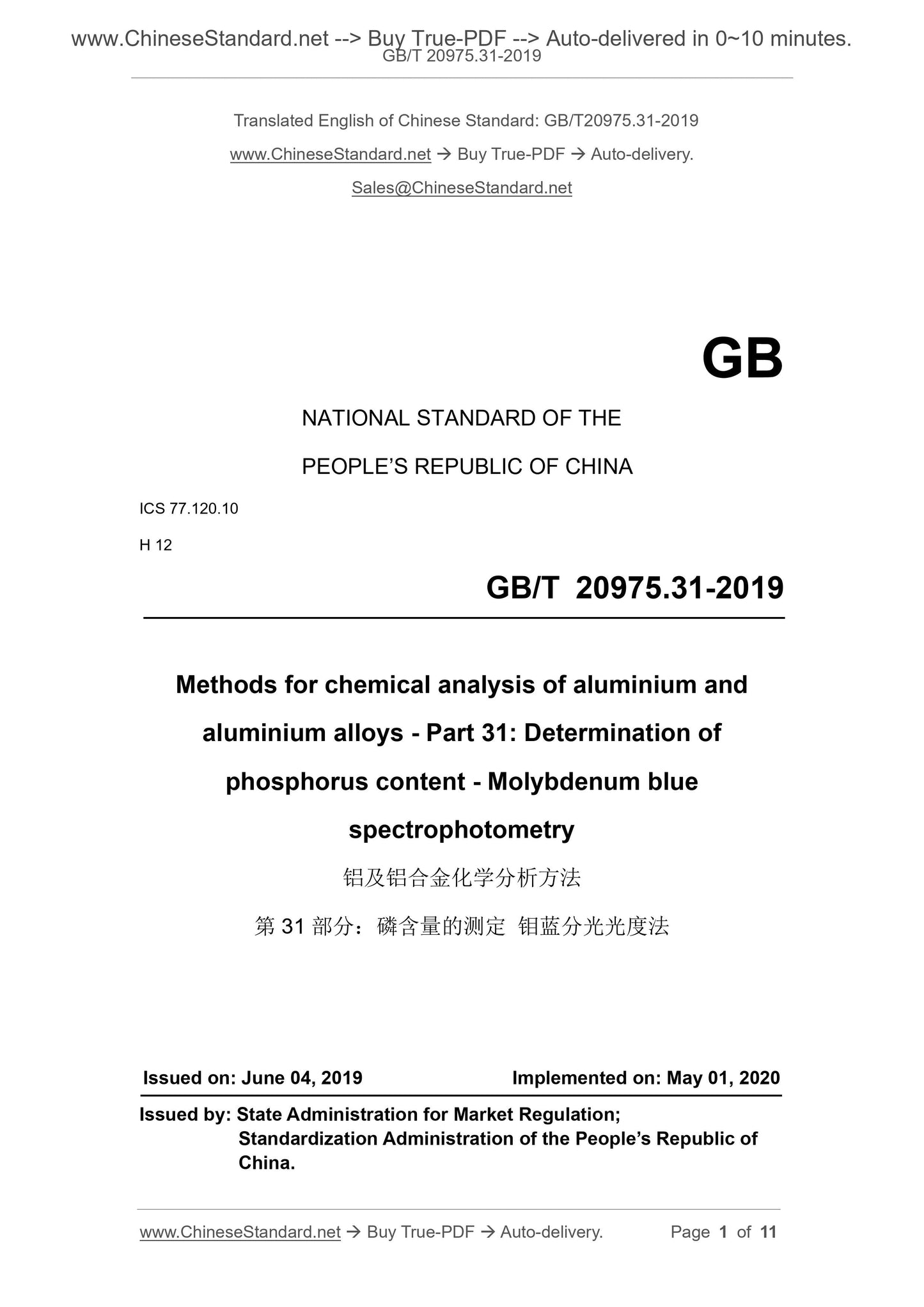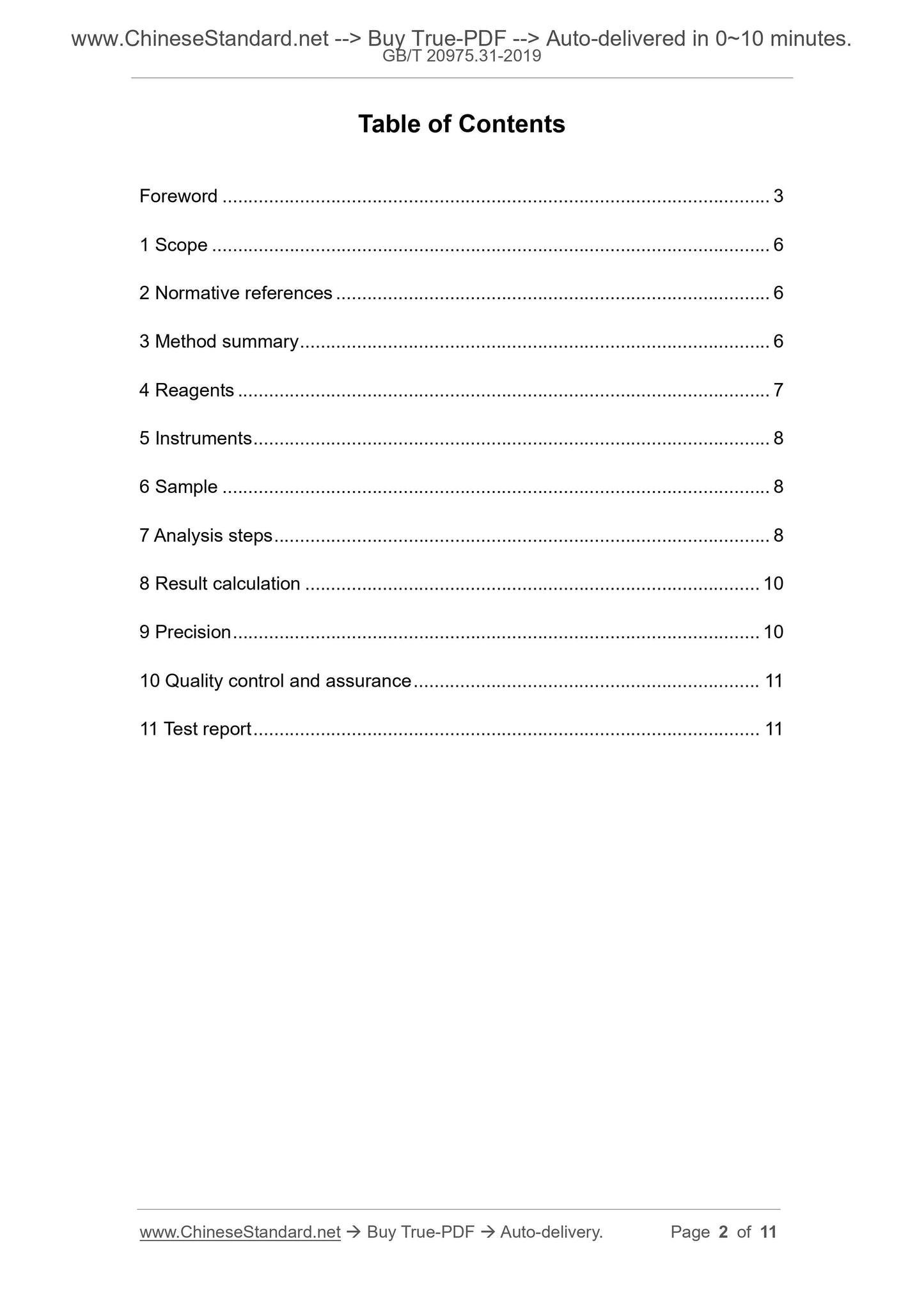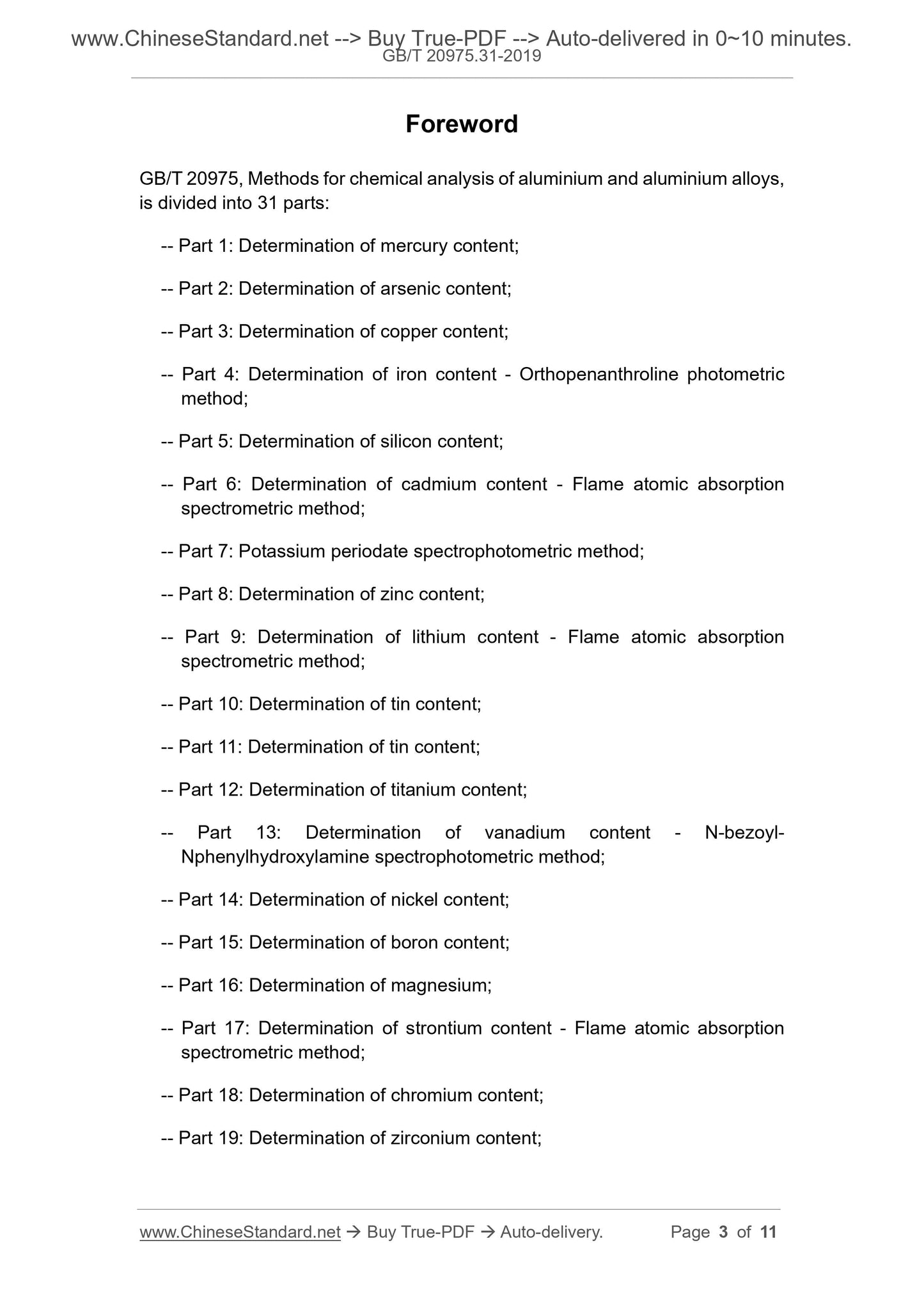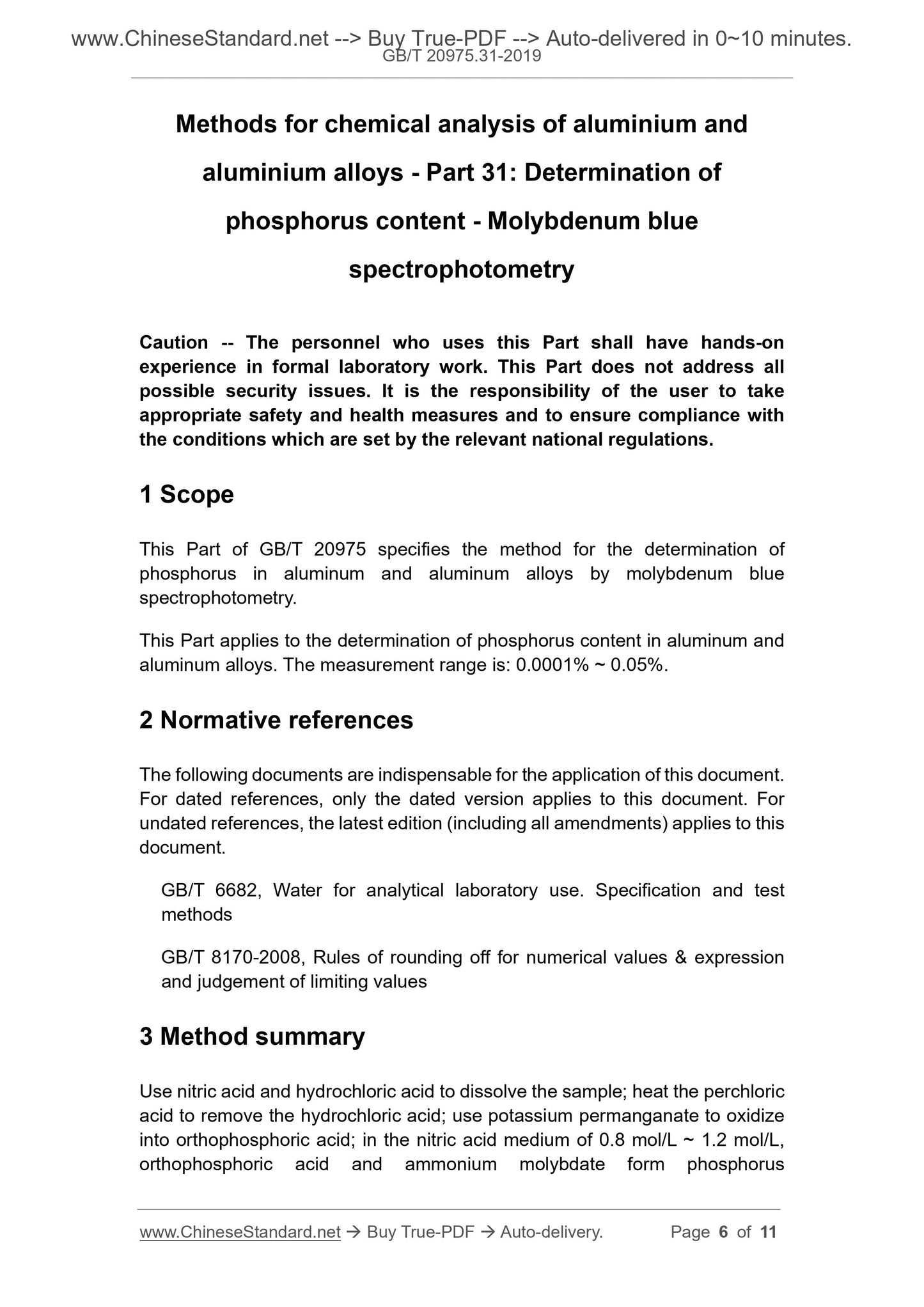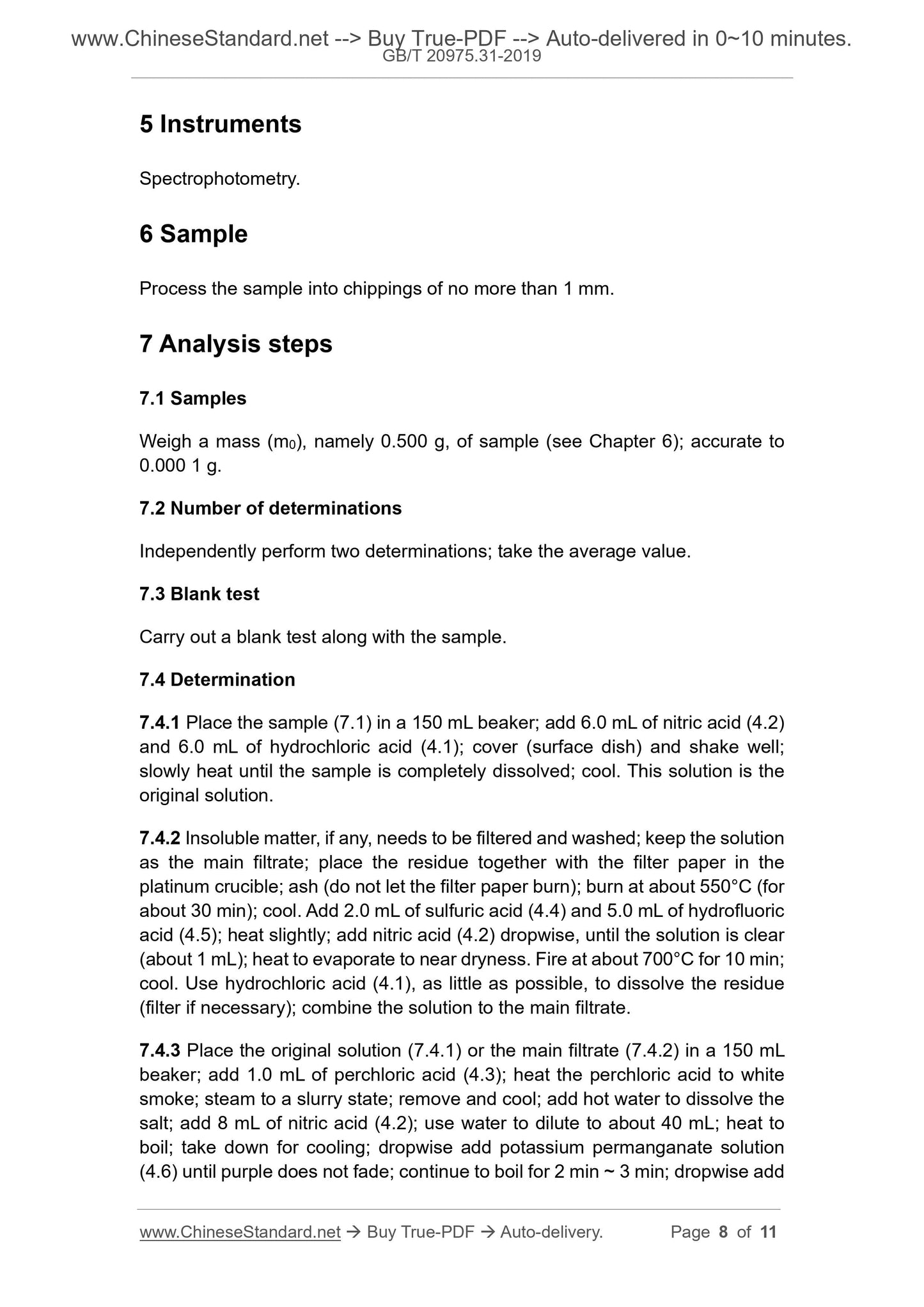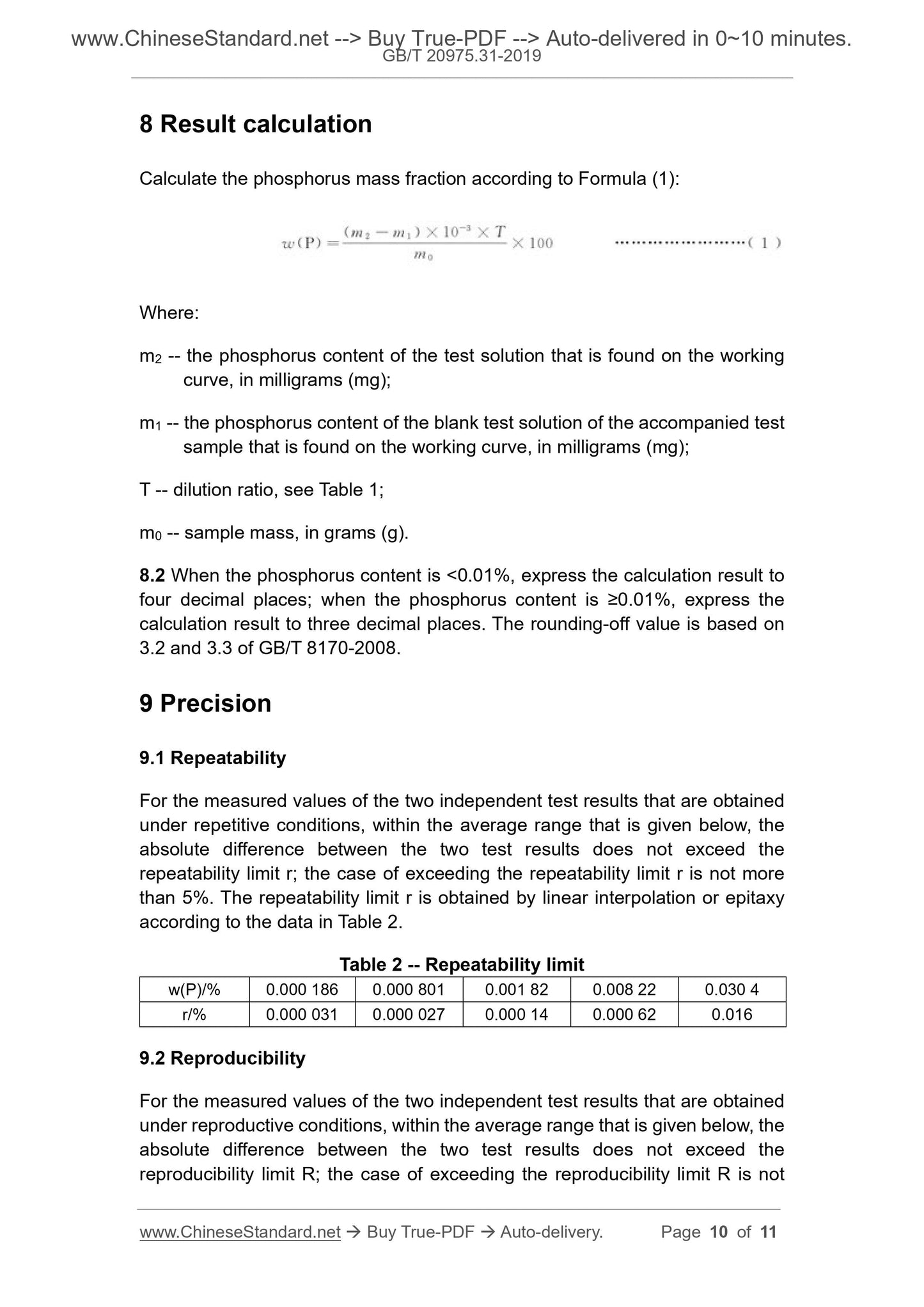1
/
of
6
www.ChineseStandard.us -- Field Test Asia Pte. Ltd.
GB/T 20975.31-2019 English PDF (GB/T20975.31-2019)
GB/T 20975.31-2019 English PDF (GB/T20975.31-2019)
Regular price
$90.00
Regular price
Sale price
$90.00
Unit price
/
per
Shipping calculated at checkout.
Couldn't load pickup availability
GB/T 20975.31-2019: Methods for chemical analysis of aluminium and aluminium alloys - Part 31: Determination of phosphorus content - Molybdenum blue spectrophotometry
Delivery: 9 seconds. Download (& Email) true-PDF + Invoice.
Get Quotation: Click GB/T 20975.31-2019 (Self-service in 1-minute)
Historical versions (Master-website): GB/T 20975.31-2019
Preview True-PDF (Reload/Scroll-down if blank)
GB/T 20975.31-2019
NATIONAL STANDARD OF THE
PEOPLE’S REPUBLIC OF CHINA
ICS 77.120.10
H 12
Methods for chemical analysis of aluminium and
aluminium alloys - Part 31: Determination of
phosphorus content - Molybdenum blue
spectrophotometry
ISSUED ON: JUNE 04, 2019
IMPLEMENTED ON: MAY 01, 2020
Issued by: State Administration for Market Regulation;
Standardization Administration of the People’s Republic of
China.
Table of Contents
Foreword ... 3
1 Scope ... 6
2 Normative references ... 6
3 Method summary ... 6
4 Reagents ... 7
5 Instruments ... 8
6 Sample ... 8
7 Analysis steps ... 8
8 Result calculation ... 10
9 Precision ... 10
10 Quality control and assurance ... 11
11 Test report ... 11
Foreword
GB/T 20975, Methods for chemical analysis of aluminium and aluminium alloys,
is divided into 31 parts:
-- Part 1: Determination of mercury content;
-- Part 2: Determination of arsenic content;
-- Part 3: Determination of copper content;
-- Part 4: Determination of iron content - Orthopenanthroline photometric
method;
-- Part 5: Determination of silicon content;
-- Part 6: Determination of cadmium content - Flame atomic absorption
spectrometric method;
-- Part 7: Potassium periodate spectrophotometric method;
-- Part 8: Determination of zinc content;
-- Part 9: Determination of lithium content - Flame atomic absorption
spectrometric method;
-- Part 10: Determination of tin content;
-- Part 11: Determination of tin content;
-- Part 12: Determination of titanium content;
-- Part 13: Determination of vanadium content - N-bezoyl-
Nphenylhydroxylamine spectrophotometric method;
-- Part 14: Determination of nickel content;
-- Part 15: Determination of boron content;
-- Part 16: Determination of magnesium;
-- Part 17: Determination of strontium content - Flame atomic absorption
spectrometric method;
-- Part 18: Determination of chromium content;
-- Part 19: Determination of zirconium content;
Methods for chemical analysis of aluminium and
aluminium alloys - Part 31: Determination of
phosphorus content - Molybdenum blue
spectrophotometry
Caution -- The personnel who uses this Part shall have hands-on
experience in formal laboratory work. This Part does not address all
possible security issues. It is the responsibility of the user to take
appropriate safety and health measures and to ensure compliance with
the conditions which are set by the relevant national regulations.
1 Scope
This Part of GB/T 20975 specifies the method for the determination of
phosphorus in aluminum and aluminum alloys by molybdenum blue
spectrophotometry.
This Part applies to the determination of phosphorus content in aluminum and
aluminum alloys. The measurement range is: 0.0001% ~ 0.05%.
2 Normative references
The following documents are indispensable for the application of this document.
For dated references, only the dated version applies to this document. For
undated references, the latest edition (including all amendments) applies to this
document.
GB/T 6682, Water for analytical laboratory use. Specification and test
methods
GB/T 8170-2008, Rules of rounding off for numerical values and expression
and judgement of limiting values
3 Method summary
Use nitric acid and hydrochloric acid to dissolve the sample; heat the perchloric
acid to remove the hydrochloric acid; use potassium permanganate to oxidize
into orthophosphoric acid; in the nitric acid medium of 0.8 mol/L ~ 1.2 mol/L,
orthophosphoric acid and ammonium molybdate form phosphorus
5 Instruments
Spectrophotometry.
6 Sample
Process the sample into chippings of no more than 1 mm.
7 Analysis steps
7.1 Samples
Weigh a mass (m0), namely 0.500 g, of sample (see Chapter 6); accurate to
0.000 1 g.
7.2 Number of determinations
Independently perform two determinations; take the average value.
7.3 Blank test
Carry out a blank test along with the sample.
7.4 Determination
7.4.1 Place the sample (7.1) in a 150 mL beaker; add 6.0 mL of nitric acid (4.2)
and 6.0 mL of hydrochloric acid (4.1); cover (surface dish) and shake well;
slowly heat until the sample is completely dissolved; cool. This solution is the
original solution.
7.4.2 Insoluble matter, if any, needs to be filtered and washed; keep the solution
as the main filtrate; place the residue together with the filter paper in the
platinum crucible; ash (do not let the filter paper burn); burn at about 550°C (for
about 30 min); cool. Add 2.0 mL of sulfuric acid (4.4) and 5.0 mL of hydrofluoric
acid (4.5); heat slightly; add nitric acid (4.2) dropwise, until the solution is clear
(about 1 mL); heat to evaporate to near dryness. Fire at about 700°C for 10 min;
cool. Use hydrochloric acid (4.1), as little as possible, to dissolve the residue
(filter if necessary); combine the solution to the main filtrate.
7.4.3 Place the original solution (7.4.1) or the main filtrate (7.4.2) in a 150 mL
beaker; add 1.0 mL of perchloric acid (4.3); heat the perchloric acid to white
smoke; steam to a slurry state; remove and cool; add hot water to dissolve the
salt; add 8 mL of nitric acid (4.2); use water to dilute to about 40 mL; heat to
boil; take down for cooling; dropwise add potassium permanganate solution
(4.6) until purple does not fade; continue to boil for 2 min ~ 3 min; dropwise add
8 Result calculation
Calculate the phosphorus mass fraction according to Formula (1):
Where:
m2 -- the phosphorus content of the test solution that is found on the working
curve, in milligrams (mg);
m1 -- the phosphorus content of the blank test solution of the accompanied test
sample that is found on the working curve, in milligrams (mg);
T -- dilution ratio, see Table 1;
m0 -- sample mass, in grams (g).
8.2 When the phosphorus content is < 0.01%, express the calculation result to
four decimal places; when the phosphorus content is ≥0.01%, express the
calculation result to three decimal places. The rounding-off value is based on
3.2 and 3.3 of GB/T 8170-2008.
9 Precision
9.1 Repeatability
For the measured values of the two independent test results that are obtained
under repetitive conditions, within the average range that is given below, the
absolute difference between the two test results does not exceed the
repeatability limit r; the case of exceeding the repeatability limit r is not more
than 5%. The repeatability limit r is obtained by linear interpolation or epitaxy
according to the data in Table 2.
Table 2 -- Repeatability limit
w(P)/% 0.000 186 0.000 801 0.001 82 0.008 22 0.030 4
r/% 0.000 031 0.000 027 0.000 14 0.000 62 0.016
9.2 Reproducibility
For the measured values of the two independent test results that are obtained
under reproductive conditions, within the average range that is given below, the
absolute difference between the two test results does not exceed the
reproducibility limit R; the case of exceeding the reproducibility limit R is not
GB/T 20975.31-2019
NATIONAL STANDARD OF THE
PEOPLE’S REPUBLIC OF CHINA
ICS 77.120.10
H 12
Methods for chemical analysis of aluminium and
aluminium alloys - Part 31: Determination of
phosphorus content - Molybdenum blue
spectrophotometry
ISSUED ON: JUNE 04, 2019
IMPLEMENTED ON: MAY 01, 2020
Issued by: State Administration for Market Regulation;
Standardization Administration of the People’s Republic of
China.
Table of Contents
Foreword ... 3
1 Scope ... 6
2 Normative references ... 6
3 Method summary ... 6
4 Reagents ... 7
5 Instruments ... 8
6 Sample ... 8
7 Analysis steps ... 8
8 Result calculation ... 10
9 Precision ... 10
10 Quality control and assurance ... 11
11 Test report ... 11
Foreword
GB/T 20975, Methods for chemical analysis of aluminium and aluminium alloys,
is divided into 31 parts:
-- Part 1: Determination of mercury content;
-- Part 2: Determination of arsenic content;
-- Part 3: Determination of copper content;
-- Part 4: Determination of iron content - Orthopenanthroline photometric
method;
-- Part 5: Determination of silicon content;
-- Part 6: Determination of cadmium content - Flame atomic absorption
spectrometric method;
-- Part 7: Potassium periodate spectrophotometric method;
-- Part 8: Determination of zinc content;
-- Part 9: Determination of lithium content - Flame atomic absorption
spectrometric method;
-- Part 10: Determination of tin content;
-- Part 11: Determination of tin content;
-- Part 12: Determination of titanium content;
-- Part 13: Determination of vanadium content - N-bezoyl-
Nphenylhydroxylamine spectrophotometric method;
-- Part 14: Determination of nickel content;
-- Part 15: Determination of boron content;
-- Part 16: Determination of magnesium;
-- Part 17: Determination of strontium content - Flame atomic absorption
spectrometric method;
-- Part 18: Determination of chromium content;
-- Part 19: Determination of zirconium content;
Methods for chemical analysis of aluminium and
aluminium alloys - Part 31: Determination of
phosphorus content - Molybdenum blue
spectrophotometry
Caution -- The personnel who uses this Part shall have hands-on
experience in formal laboratory work. This Part does not address all
possible security issues. It is the responsibility of the user to take
appropriate safety and health measures and to ensure compliance with
the conditions which are set by the relevant national regulations.
1 Scope
This Part of GB/T 20975 specifies the method for the determination of
phosphorus in aluminum and aluminum alloys by molybdenum blue
spectrophotometry.
This Part applies to the determination of phosphorus content in aluminum and
aluminum alloys. The measurement range is: 0.0001% ~ 0.05%.
2 Normative references
The following documents are indispensable for the application of this document.
For dated references, only the dated version applies to this document. For
undated references, the latest edition (including all amendments) applies to this
document.
GB/T 6682, Water for analytical laboratory use. Specification and test
methods
GB/T 8170-2008, Rules of rounding off for numerical values and expression
and judgement of limiting values
3 Method summary
Use nitric acid and hydrochloric acid to dissolve the sample; heat the perchloric
acid to remove the hydrochloric acid; use potassium permanganate to oxidize
into orthophosphoric acid; in the nitric acid medium of 0.8 mol/L ~ 1.2 mol/L,
orthophosphoric acid and ammonium molybdate form phosphorus
5 Instruments
Spectrophotometry.
6 Sample
Process the sample into chippings of no more than 1 mm.
7 Analysis steps
7.1 Samples
Weigh a mass (m0), namely 0.500 g, of sample (see Chapter 6); accurate to
0.000 1 g.
7.2 Number of determinations
Independently perform two determinations; take the average value.
7.3 Blank test
Carry out a blank test along with the sample.
7.4 Determination
7.4.1 Place the sample (7.1) in a 150 mL beaker; add 6.0 mL of nitric acid (4.2)
and 6.0 mL of hydrochloric acid (4.1); cover (surface dish) and shake well;
slowly heat until the sample is completely dissolved; cool. This solution is the
original solution.
7.4.2 Insoluble matter, if any, needs to be filtered and washed; keep the solution
as the main filtrate; place the residue together with the filter paper in the
platinum crucible; ash (do not let the filter paper burn); burn at about 550°C (for
about 30 min); cool. Add 2.0 mL of sulfuric acid (4.4) and 5.0 mL of hydrofluoric
acid (4.5); heat slightly; add nitric acid (4.2) dropwise, until the solution is clear
(about 1 mL); heat to evaporate to near dryness. Fire at about 700°C for 10 min;
cool. Use hydrochloric acid (4.1), as little as possible, to dissolve the residue
(filter if necessary); combine the solution to the main filtrate.
7.4.3 Place the original solution (7.4.1) or the main filtrate (7.4.2) in a 150 mL
beaker; add 1.0 mL of perchloric acid (4.3); heat the perchloric acid to white
smoke; steam to a slurry state; remove and cool; add hot water to dissolve the
salt; add 8 mL of nitric acid (4.2); use water to dilute to about 40 mL; heat to
boil; take down for cooling; dropwise add potassium permanganate solution
(4.6) until purple does not fade; continue to boil for 2 min ~ 3 min; dropwise add
8 Result calculation
Calculate the phosphorus mass fraction according to Formula (1):
Where:
m2 -- the phosphorus content of the test solution that is found on the working
curve, in milligrams (mg);
m1 -- the phosphorus content of the blank test solution of the accompanied test
sample that is found on the working curve, in milligrams (mg);
T -- dilution ratio, see Table 1;
m0 -- sample mass, in grams (g).
8.2 When the phosphorus content is < 0.01%, express the calculation result to
four decimal places; when the phosphorus content is ≥0.01%, express the
calculation result to three decimal places. The rounding-off value is based on
3.2 and 3.3 of GB/T 8170-2008.
9 Precision
9.1 Repeatability
For the measured values of the two independent test results that are obtained
under repetitive conditions, within the average range that is given below, the
absolute difference between the two test results does not exceed the
repeatability limit r; the case of exceeding the repeatability limit r is not more
than 5%. The repeatability limit r is obtained by linear interpolation or epitaxy
according to the data in Table 2.
Table 2 -- Repeatability limit
w(P)/% 0.000 186 0.000 801 0.001 82 0.008 22 0.030 4
r/% 0.000 031 0.000 027 0.000 14 0.000 62 0.016
9.2 Reproducibility
For the measured values of the two independent test results that are obtained
under reproductive conditions, within the average range that is given below, the
absolute difference between the two test results does not exceed the
reproducibili...
Delivery: 9 seconds. Download (& Email) true-PDF + Invoice.
Get Quotation: Click GB/T 20975.31-2019 (Self-service in 1-minute)
Historical versions (Master-website): GB/T 20975.31-2019
Preview True-PDF (Reload/Scroll-down if blank)
GB/T 20975.31-2019
NATIONAL STANDARD OF THE
PEOPLE’S REPUBLIC OF CHINA
ICS 77.120.10
H 12
Methods for chemical analysis of aluminium and
aluminium alloys - Part 31: Determination of
phosphorus content - Molybdenum blue
spectrophotometry
ISSUED ON: JUNE 04, 2019
IMPLEMENTED ON: MAY 01, 2020
Issued by: State Administration for Market Regulation;
Standardization Administration of the People’s Republic of
China.
Table of Contents
Foreword ... 3
1 Scope ... 6
2 Normative references ... 6
3 Method summary ... 6
4 Reagents ... 7
5 Instruments ... 8
6 Sample ... 8
7 Analysis steps ... 8
8 Result calculation ... 10
9 Precision ... 10
10 Quality control and assurance ... 11
11 Test report ... 11
Foreword
GB/T 20975, Methods for chemical analysis of aluminium and aluminium alloys,
is divided into 31 parts:
-- Part 1: Determination of mercury content;
-- Part 2: Determination of arsenic content;
-- Part 3: Determination of copper content;
-- Part 4: Determination of iron content - Orthopenanthroline photometric
method;
-- Part 5: Determination of silicon content;
-- Part 6: Determination of cadmium content - Flame atomic absorption
spectrometric method;
-- Part 7: Potassium periodate spectrophotometric method;
-- Part 8: Determination of zinc content;
-- Part 9: Determination of lithium content - Flame atomic absorption
spectrometric method;
-- Part 10: Determination of tin content;
-- Part 11: Determination of tin content;
-- Part 12: Determination of titanium content;
-- Part 13: Determination of vanadium content - N-bezoyl-
Nphenylhydroxylamine spectrophotometric method;
-- Part 14: Determination of nickel content;
-- Part 15: Determination of boron content;
-- Part 16: Determination of magnesium;
-- Part 17: Determination of strontium content - Flame atomic absorption
spectrometric method;
-- Part 18: Determination of chromium content;
-- Part 19: Determination of zirconium content;
Methods for chemical analysis of aluminium and
aluminium alloys - Part 31: Determination of
phosphorus content - Molybdenum blue
spectrophotometry
Caution -- The personnel who uses this Part shall have hands-on
experience in formal laboratory work. This Part does not address all
possible security issues. It is the responsibility of the user to take
appropriate safety and health measures and to ensure compliance with
the conditions which are set by the relevant national regulations.
1 Scope
This Part of GB/T 20975 specifies the method for the determination of
phosphorus in aluminum and aluminum alloys by molybdenum blue
spectrophotometry.
This Part applies to the determination of phosphorus content in aluminum and
aluminum alloys. The measurement range is: 0.0001% ~ 0.05%.
2 Normative references
The following documents are indispensable for the application of this document.
For dated references, only the dated version applies to this document. For
undated references, the latest edition (including all amendments) applies to this
document.
GB/T 6682, Water for analytical laboratory use. Specification and test
methods
GB/T 8170-2008, Rules of rounding off for numerical values and expression
and judgement of limiting values
3 Method summary
Use nitric acid and hydrochloric acid to dissolve the sample; heat the perchloric
acid to remove the hydrochloric acid; use potassium permanganate to oxidize
into orthophosphoric acid; in the nitric acid medium of 0.8 mol/L ~ 1.2 mol/L,
orthophosphoric acid and ammonium molybdate form phosphorus
5 Instruments
Spectrophotometry.
6 Sample
Process the sample into chippings of no more than 1 mm.
7 Analysis steps
7.1 Samples
Weigh a mass (m0), namely 0.500 g, of sample (see Chapter 6); accurate to
0.000 1 g.
7.2 Number of determinations
Independently perform two determinations; take the average value.
7.3 Blank test
Carry out a blank test along with the sample.
7.4 Determination
7.4.1 Place the sample (7.1) in a 150 mL beaker; add 6.0 mL of nitric acid (4.2)
and 6.0 mL of hydrochloric acid (4.1); cover (surface dish) and shake well;
slowly heat until the sample is completely dissolved; cool. This solution is the
original solution.
7.4.2 Insoluble matter, if any, needs to be filtered and washed; keep the solution
as the main filtrate; place the residue together with the filter paper in the
platinum crucible; ash (do not let the filter paper burn); burn at about 550°C (for
about 30 min); cool. Add 2.0 mL of sulfuric acid (4.4) and 5.0 mL of hydrofluoric
acid (4.5); heat slightly; add nitric acid (4.2) dropwise, until the solution is clear
(about 1 mL); heat to evaporate to near dryness. Fire at about 700°C for 10 min;
cool. Use hydrochloric acid (4.1), as little as possible, to dissolve the residue
(filter if necessary); combine the solution to the main filtrate.
7.4.3 Place the original solution (7.4.1) or the main filtrate (7.4.2) in a 150 mL
beaker; add 1.0 mL of perchloric acid (4.3); heat the perchloric acid to white
smoke; steam to a slurry state; remove and cool; add hot water to dissolve the
salt; add 8 mL of nitric acid (4.2); use water to dilute to about 40 mL; heat to
boil; take down for cooling; dropwise add potassium permanganate solution
(4.6) until purple does not fade; continue to boil for 2 min ~ 3 min; dropwise add
8 Result calculation
Calculate the phosphorus mass fraction according to Formula (1):
Where:
m2 -- the phosphorus content of the test solution that is found on the working
curve, in milligrams (mg);
m1 -- the phosphorus content of the blank test solution of the accompanied test
sample that is found on the working curve, in milligrams (mg);
T -- dilution ratio, see Table 1;
m0 -- sample mass, in grams (g).
8.2 When the phosphorus content is < 0.01%, express the calculation result to
four decimal places; when the phosphorus content is ≥0.01%, express the
calculation result to three decimal places. The rounding-off value is based on
3.2 and 3.3 of GB/T 8170-2008.
9 Precision
9.1 Repeatability
For the measured values of the two independent test results that are obtained
under repetitive conditions, within the average range that is given below, the
absolute difference between the two test results does not exceed the
repeatability limit r; the case of exceeding the repeatability limit r is not more
than 5%. The repeatability limit r is obtained by linear interpolation or epitaxy
according to the data in Table 2.
Table 2 -- Repeatability limit
w(P)/% 0.000 186 0.000 801 0.001 82 0.008 22 0.030 4
r/% 0.000 031 0.000 027 0.000 14 0.000 62 0.016
9.2 Reproducibility
For the measured values of the two independent test results that are obtained
under reproductive conditions, within the average range that is given below, the
absolute difference between the two test results does not exceed the
reproducibility limit R; the case of exceeding the reproducibility limit R is not
GB/T 20975.31-2019
NATIONAL STANDARD OF THE
PEOPLE’S REPUBLIC OF CHINA
ICS 77.120.10
H 12
Methods for chemical analysis of aluminium and
aluminium alloys - Part 31: Determination of
phosphorus content - Molybdenum blue
spectrophotometry
ISSUED ON: JUNE 04, 2019
IMPLEMENTED ON: MAY 01, 2020
Issued by: State Administration for Market Regulation;
Standardization Administration of the People’s Republic of
China.
Table of Contents
Foreword ... 3
1 Scope ... 6
2 Normative references ... 6
3 Method summary ... 6
4 Reagents ... 7
5 Instruments ... 8
6 Sample ... 8
7 Analysis steps ... 8
8 Result calculation ... 10
9 Precision ... 10
10 Quality control and assurance ... 11
11 Test report ... 11
Foreword
GB/T 20975, Methods for chemical analysis of aluminium and aluminium alloys,
is divided into 31 parts:
-- Part 1: Determination of mercury content;
-- Part 2: Determination of arsenic content;
-- Part 3: Determination of copper content;
-- Part 4: Determination of iron content - Orthopenanthroline photometric
method;
-- Part 5: Determination of silicon content;
-- Part 6: Determination of cadmium content - Flame atomic absorption
spectrometric method;
-- Part 7: Potassium periodate spectrophotometric method;
-- Part 8: Determination of zinc content;
-- Part 9: Determination of lithium content - Flame atomic absorption
spectrometric method;
-- Part 10: Determination of tin content;
-- Part 11: Determination of tin content;
-- Part 12: Determination of titanium content;
-- Part 13: Determination of vanadium content - N-bezoyl-
Nphenylhydroxylamine spectrophotometric method;
-- Part 14: Determination of nickel content;
-- Part 15: Determination of boron content;
-- Part 16: Determination of magnesium;
-- Part 17: Determination of strontium content - Flame atomic absorption
spectrometric method;
-- Part 18: Determination of chromium content;
-- Part 19: Determination of zirconium content;
Methods for chemical analysis of aluminium and
aluminium alloys - Part 31: Determination of
phosphorus content - Molybdenum blue
spectrophotometry
Caution -- The personnel who uses this Part shall have hands-on
experience in formal laboratory work. This Part does not address all
possible security issues. It is the responsibility of the user to take
appropriate safety and health measures and to ensure compliance with
the conditions which are set by the relevant national regulations.
1 Scope
This Part of GB/T 20975 specifies the method for the determination of
phosphorus in aluminum and aluminum alloys by molybdenum blue
spectrophotometry.
This Part applies to the determination of phosphorus content in aluminum and
aluminum alloys. The measurement range is: 0.0001% ~ 0.05%.
2 Normative references
The following documents are indispensable for the application of this document.
For dated references, only the dated version applies to this document. For
undated references, the latest edition (including all amendments) applies to this
document.
GB/T 6682, Water for analytical laboratory use. Specification and test
methods
GB/T 8170-2008, Rules of rounding off for numerical values and expression
and judgement of limiting values
3 Method summary
Use nitric acid and hydrochloric acid to dissolve the sample; heat the perchloric
acid to remove the hydrochloric acid; use potassium permanganate to oxidize
into orthophosphoric acid; in the nitric acid medium of 0.8 mol/L ~ 1.2 mol/L,
orthophosphoric acid and ammonium molybdate form phosphorus
5 Instruments
Spectrophotometry.
6 Sample
Process the sample into chippings of no more than 1 mm.
7 Analysis steps
7.1 Samples
Weigh a mass (m0), namely 0.500 g, of sample (see Chapter 6); accurate to
0.000 1 g.
7.2 Number of determinations
Independently perform two determinations; take the average value.
7.3 Blank test
Carry out a blank test along with the sample.
7.4 Determination
7.4.1 Place the sample (7.1) in a 150 mL beaker; add 6.0 mL of nitric acid (4.2)
and 6.0 mL of hydrochloric acid (4.1); cover (surface dish) and shake well;
slowly heat until the sample is completely dissolved; cool. This solution is the
original solution.
7.4.2 Insoluble matter, if any, needs to be filtered and washed; keep the solution
as the main filtrate; place the residue together with the filter paper in the
platinum crucible; ash (do not let the filter paper burn); burn at about 550°C (for
about 30 min); cool. Add 2.0 mL of sulfuric acid (4.4) and 5.0 mL of hydrofluoric
acid (4.5); heat slightly; add nitric acid (4.2) dropwise, until the solution is clear
(about 1 mL); heat to evaporate to near dryness. Fire at about 700°C for 10 min;
cool. Use hydrochloric acid (4.1), as little as possible, to dissolve the residue
(filter if necessary); combine the solution to the main filtrate.
7.4.3 Place the original solution (7.4.1) or the main filtrate (7.4.2) in a 150 mL
beaker; add 1.0 mL of perchloric acid (4.3); heat the perchloric acid to white
smoke; steam to a slurry state; remove and cool; add hot water to dissolve the
salt; add 8 mL of nitric acid (4.2); use water to dilute to about 40 mL; heat to
boil; take down for cooling; dropwise add potassium permanganate solution
(4.6) until purple does not fade; continue to boil for 2 min ~ 3 min; dropwise add
8 Result calculation
Calculate the phosphorus mass fraction according to Formula (1):
Where:
m2 -- the phosphorus content of the test solution that is found on the working
curve, in milligrams (mg);
m1 -- the phosphorus content of the blank test solution of the accompanied test
sample that is found on the working curve, in milligrams (mg);
T -- dilution ratio, see Table 1;
m0 -- sample mass, in grams (g).
8.2 When the phosphorus content is < 0.01%, express the calculation result to
four decimal places; when the phosphorus content is ≥0.01%, express the
calculation result to three decimal places. The rounding-off value is based on
3.2 and 3.3 of GB/T 8170-2008.
9 Precision
9.1 Repeatability
For the measured values of the two independent test results that are obtained
under repetitive conditions, within the average range that is given below, the
absolute difference between the two test results does not exceed the
repeatability limit r; the case of exceeding the repeatability limit r is not more
than 5%. The repeatability limit r is obtained by linear interpolation or epitaxy
according to the data in Table 2.
Table 2 -- Repeatability limit
w(P)/% 0.000 186 0.000 801 0.001 82 0.008 22 0.030 4
r/% 0.000 031 0.000 027 0.000 14 0.000 62 0.016
9.2 Reproducibility
For the measured values of the two independent test results that are obtained
under reproductive conditions, within the average range that is given below, the
absolute difference between the two test results does not exceed the
reproducibili...
Share
